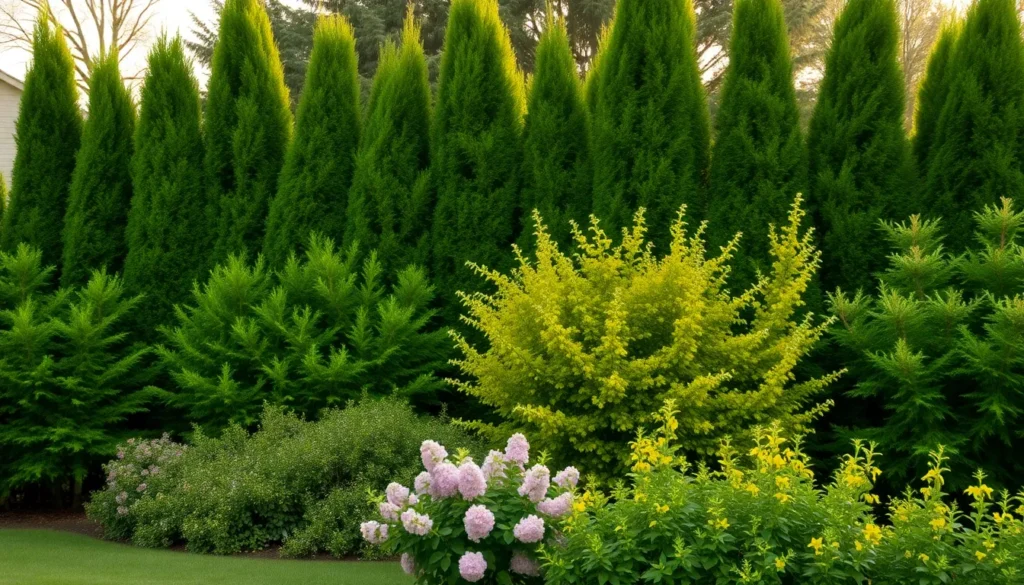We’ve all experienced that uncomfortable feeling when neighbors seem a bit too interested in our backyard activities. Whether you’re hosting a barbecue or simply enjoying a quiet morning coffee, creating a natural barrier between your space and prying eyes becomes essential for true relaxation.
Living privacy fences offer the perfect solution – combining the functionality of traditional fencing with nature’s beauty. These green barriers don’t just block unwanted views; they transform your outdoor space into a lush sanctuary that changes with the seasons.
We’ll explore creative plant-based privacy answers that work faster than you’d expect and cost less than installing traditional wooden or vinyl fencing. From fast-growing evergreen hedges to mixed plantings that provide year-round coverage, these natural privacy screens will turn your yard into the private retreat you’ve always wanted.
Fast-Growing Evergreen Trees for Instant Privacy
Evergreen trees offer the perfect solution when you need privacy coverage that won’t disappear during winter months. These natural privacy screens can transform your outdoor space within just a few growing seasons.
Leyland Cypress for Year-Round Coverage
Leyland cypress stands out as one of the fastest growing privacy trees, reaching heights of 3 to 4 feet per year under optimal conditions. We’ve seen these versatile conifers create effective privacy barriers in just 2 to 3 years when planted properly.
Growth characteristics make Leyland cypress particularly appealing for privacy applications:
- Height potential: Reaches 40 to 60 feet at maturity
- Width spread: Grows 15 to 25 feet wide without pruning
- Spacing requirements: Plant 6 to 8 feet apart for screening
- Maintenance needs: Requires annual pruning to maintain shape
Soil adaptability allows Leyland cypress to thrive in various conditions, from clay to sandy soils with pH levels between 6.0 and 8.0. These trees tolerate drought conditions once established but perform best with consistent moisture during their first two growing seasons.
Arborvitae Varieties for Dense Screening
Arborvitae species provide some of the densest natural screening available, with their tight branching pattern creating solid privacy walls. Green Giant arborvitae leads the pack with growth rates of 3 to 5 feet annually.
Popular arborvitae varieties for privacy screening include:
| Variety | Annual Growth Rate | Mature Height | Mature Width | Spacing |
|---|---|---|---|---|
| Green Giant | 3-5 feet | 50-60 feet | 12-18 feet | 5-6 feet |
| Emerald Green | 1-2 feet | 12-15 feet | 3-4 feet | 3-4 feet |
| American Arborvitae | 1-2 feet | 40-60 feet | 10-15 feet | 4-6 feet |
Planting considerations require attention to drainage since arborvitae species prefer well draining soil and can develop root rot in waterlogged conditions. We recommend adding organic matter to heavy clay soils and ensuring proper spacing to prevent overcrowding as trees mature.
Bamboo Species for Rapid Growth
Bamboo delivers the fastest privacy screening option, with some clumping varieties growing 2 to 4 feet in height within a single growing season. Clumping bamboo species stay contained naturally, unlike running varieties that can spread aggressively.
Recommended clumping bamboo varieties for privacy include:
- Graceful bamboo (Bambusa textilis gracilis): Grows 20 to 25 feet tall
- Golden bamboo (Bambusa vulgaris): Reaches 30 to 40 feet in height
- Buddha’s belly bamboo (Bambusa ventricosa): Stays compact at 10 to 15 feet
- Multiplex bamboo (Bambusa multiplex): Grows 15 to 25 feet tall
Installation tips ensure successful bamboo privacy screens by planting in spring after the last frost date. Space plants 3 to 5 feet apart for faster coverage, and provide regular watering during the establishment period. Most bamboo species reach full screening height within 2 to 3 years when planted in suitable conditions.
Flowering Shrubs That Double as Privacy Barriers
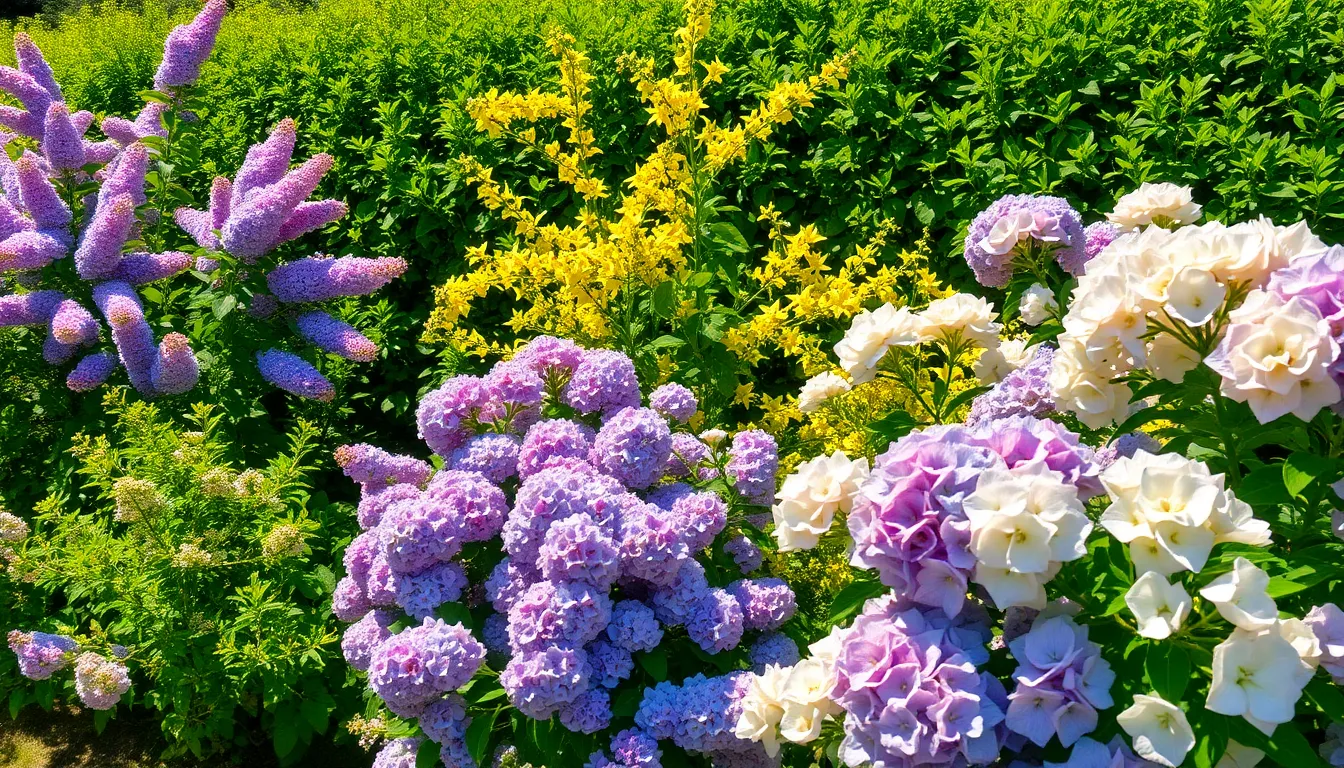
While evergreens provide year-round coverage, flowering shrubs offer the perfect combination of privacy screening and seasonal beauty that transforms your outdoor space into a colorful retreat.
Lilac Bushes for Fragrant Boundaries
Lilac bushes create dense natural barriers while filling your garden with sweet fragrance throughout the growing season. These hardy shrubs grow into substantial screens that reach several feet in height, providing both visual privacy and delightful scent. We recommend planting lilacs in full sun locations where they’ll thrive across many hardiness zones. Their classic charm makes them ideal for creating traditional garden boundaries that offer both function and timeless appeal.
Forsythia for Bright Spring Color
Forsythia shrubs deliver vibrant yellow blooms in early spring, creating cheerful privacy screens that brighten any property boundary. These vigorous growers can be easily shaped into hedges that provide effective screening while adding striking seasonal color. We’ve found forsythia particularly easy to maintain, making it perfect for homeowners who want beautiful privacy without extensive upkeep. Their rapid growth habit ensures you’ll have an established hedge relatively quickly.
Hydrangeas for Large Blooming Hedges
Hydrangeas offer impressive flower heads that create stunning privacy barriers with year-round ornamental value. The ‘Limelight’ panicle hydrangea grows 3 to 5 feet tall, making it ideal for creating substantial living screens that provide excellent coverage. Dwarf varieties like ‘Little Lime’ deliver the same colorful blooms on shorter plants, perfect for areas where lower hedging works better. We recommend these versatile shrubs for zones 3 through 8, where they’ll thrive in part sun to full sun conditions while adding both privacy and industry appeal to your property.
Climbing Vines to Transform Existing Fences
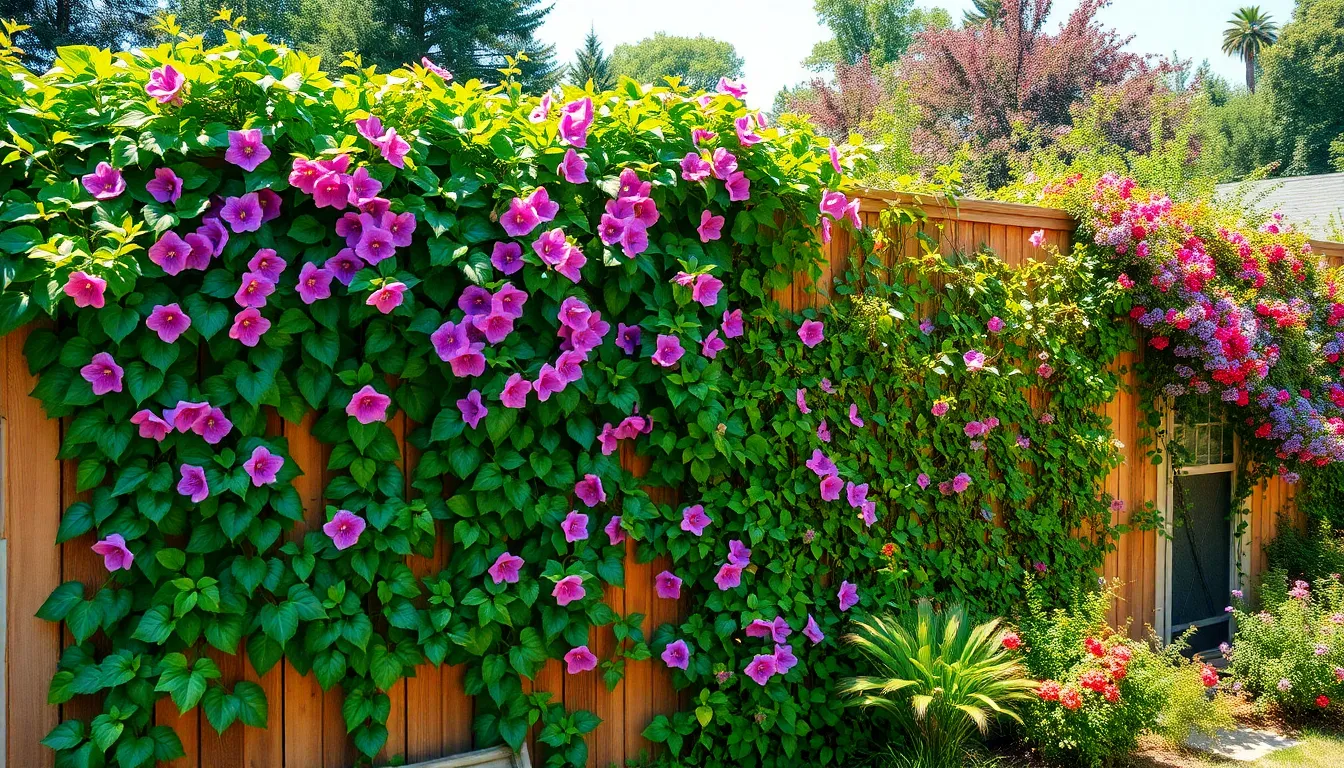
We can easily convert any plain fence into a lush privacy screen by adding climbing vines that grow vertically along existing structures. These versatile plants use fences, trellises, and arbors as support systems while creating dense natural barriers that block unwanted views.
Ivy Coverage for Classic Green Walls
Traditional ivy creates the most reliable evergreen coverage for year-round privacy screening along fence lines. Dense foliage forms classic green walls that maintain their appearance through all seasons without seasonal die-back. We recommend ivy for homeowners seeking consistent coverage that requires minimal seasonal maintenance once established.
Established ivy plants cling naturally to fence surfaces and fill gaps between boards or slats effectively. Growth patterns create uniform coverage that eliminates see-through areas common with other climbing plants. Most ivy varieties tolerate various light conditions from full sun to partial shade, making them adaptable to different fence orientations.
Clematis Varieties for Colorful Displays
Vigorous clematis varieties can cover fences up to 20-40 feet in length while producing abundant flowers throughout the growing season. We particularly recommend Clematis montana ‘Elizabeth’ for its pale pink, scented flowers that bloom in spring and its recognition with an RHS Award of Garden Merit.
Spring bloomers and repeat bloomers offer months of flowering options that extend the visual appeal beyond basic privacy screening. Clematis montana thrives in sunny, well-drained conditions and tolerates a wide range of soil types when roots receive slight shade. Annual pruning maintains best growth outcomes and encourages maximum coverage along fence lines.
Different clematis varieties are grouped by bloom time and characteristics, allowing us to select options that match exact flowering preferences. These plants add both color and fragrance to privacy installations, making them perfect for ornamental purposes alongside screening functions.
Honeysuckle for Sweet-Scented Privacy
Honeysuckle varieties provide dense foliage coverage while offering attractive, fragrant flowers that enhance the sensory experience of garden privacy walls. We find these plants particularly effective for creating pleasant outdoor spaces where scent matters as much as visual screening.
Multiple Lonicera species deliver both privacy screening and aromatic benefits throughout the growing season. Fragrant flowers create delightful scents that make time spent near privacy fences more enjoyable compared to purely functional barriers. Most honeysuckle varieties establish quickly and maintain consistent coverage once mature.
Dense growth patterns effectively screen views while creating habitat for beneficial insects and wildlife. We recommend honeysuckle for homeowners who want privacy answers that contribute to garden network health while maintaining beautiful appearances.
Layered Planting Strategies for Maximum Coverage
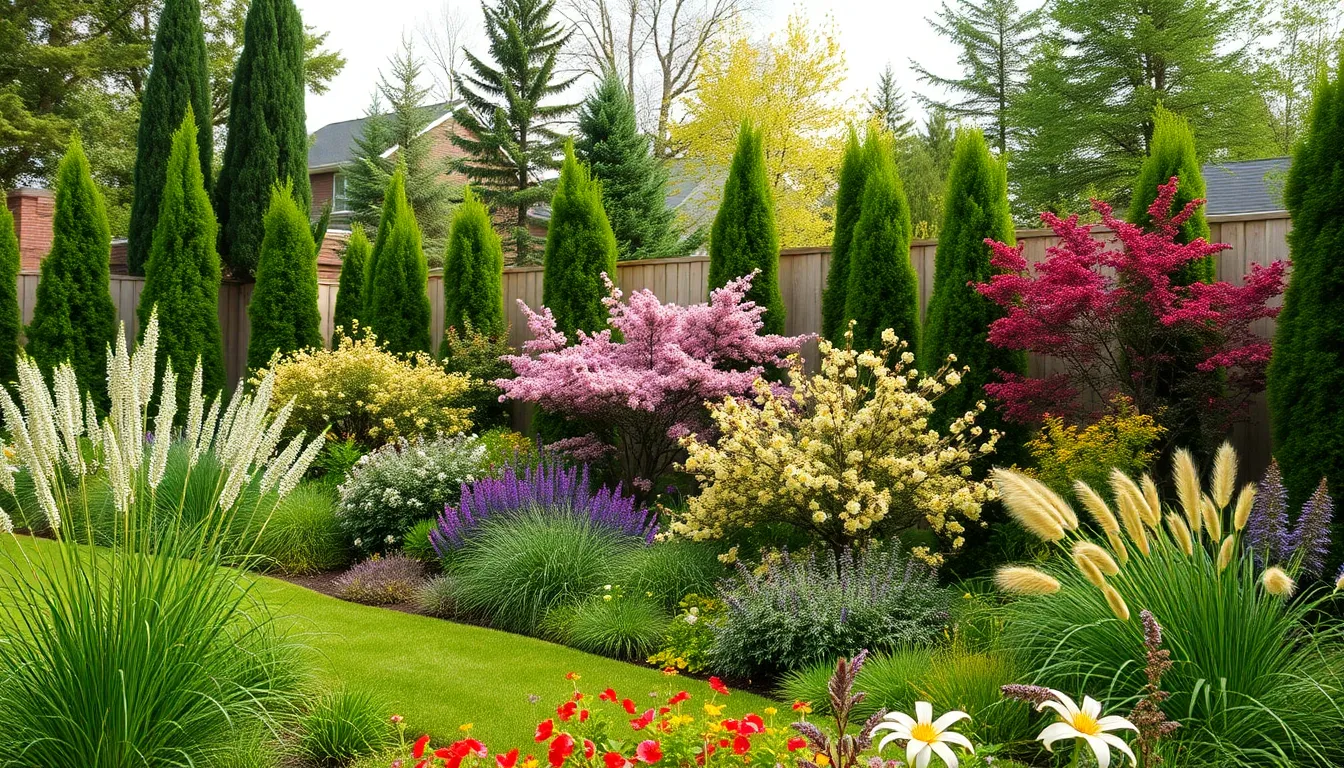
We’ve found that the most effective approach to plant based privacy involves creating layers of vegetation at different heights. This three tiered strategy ensures complete visual blocking while maintaining a natural garden appearance.
Tall Background Plants for Primary Screening
Arborvitae varieties form the backbone of our tallest screening layer. These evergreen trees provide year round foliage density and can reach impressive heights for consistent privacy coverage. Leyland cypress offers another excellent choice for primary screening, growing 3 to 4 feet annually and reaching mature heights of 40 to 60 feet. Hick’s Yew creates a more compact option for smaller spaces while still delivering solid screening performance. Holly trees add both privacy and seasonal interest with their glossy leaves and colorful berries.
Columnar evergreens work particularly well when space is limited since they grow upward rather than outward. Japanese maples provide softer screening with their delicate foliage and seasonal color changes. Redbud trees offer spring flowering beauty while maintaining coverage through their broad canopies. Olive trees create Mediterranean style privacy with their silvery foliage and graceful form.
Medium-Height Shrubs for Filling Gaps
Flowering shrubs bridge the gap between tall trees and ground level plants. These medium height options typically grow 6 to 8 feet tall and help eliminate visual gaps in your privacy barrier. Bushy evergreen shrubs provide consistent coverage throughout all seasons without seasonal leaf drop. Tall perennials like ornamental grasses add movement and texture while maintaining screening effectiveness.
Lilac bushes create dense natural barriers while offering seasonal fragrance and beautiful spring blooms. Forsythia shrubs deliver vibrant yellow flowers in early spring and grow quickly to fill screening gaps. Hydrangea varieties like ‘Limelight’ provide substantial coverage with impressive flowering displays. Mixed plantings of these shrubs create visual interest while ensuring complete privacy coverage.
Ground Cover Plants for Complete Coverage
Low growing plants complete our layered privacy system by covering the space near ground level where gaps often occur. Ornamental grasses such as Panicum and Miscanthus provide soft textures and seasonal movement in the lower layer. These plants also suppress weeds naturally while preventing soil erosion along fence lines.
Flowering perennials add color and interest to the front edge of privacy plantings without blocking beneficial light. Small shrubs create structure in the ground cover layer while maintaining the natural appearance of the overall design. Spreading plants help tie together the visual elements of the layered system while providing complete coverage from different viewing angles.
Low-Maintenance Native Plants for Sustainable Privacy
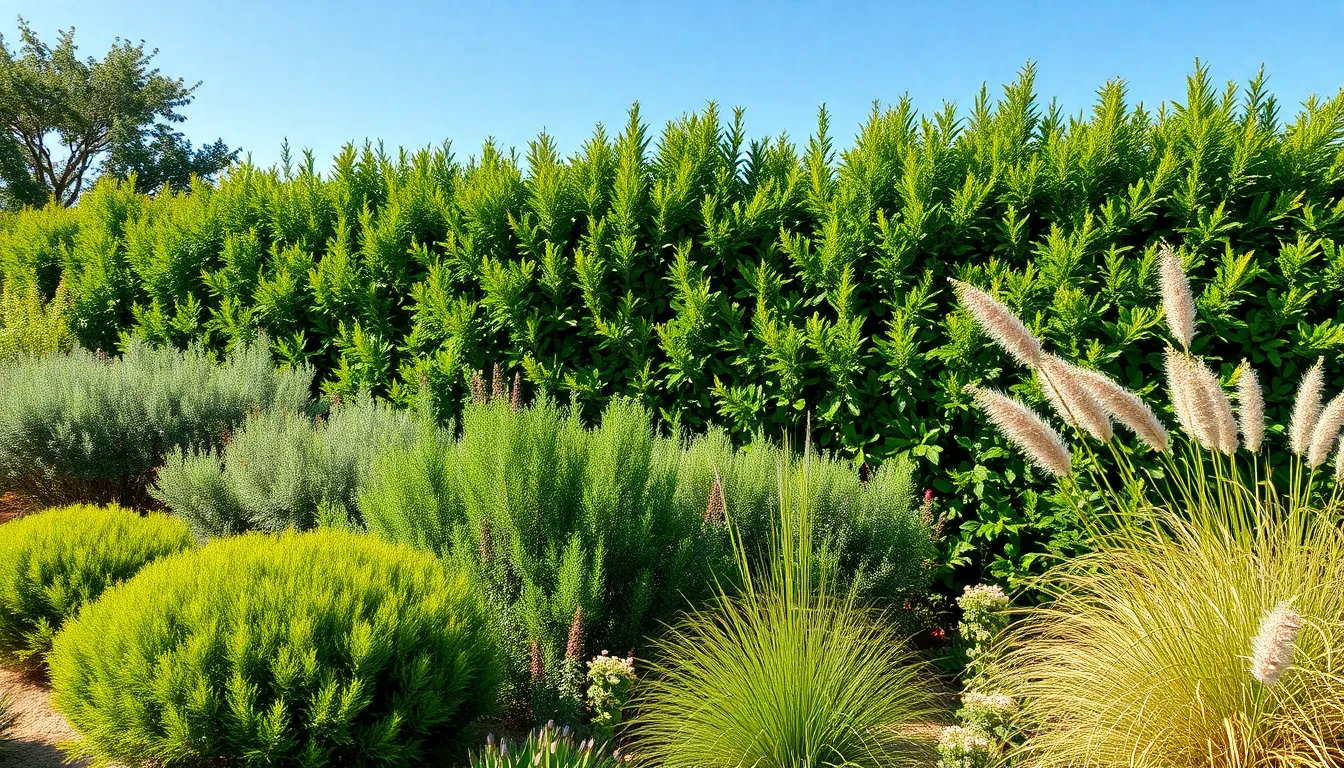
Native plants offer the perfect balance of beauty and sustainability for your privacy fence needs. These plants require minimal care once established and support local ecosystems while providing effective screening.
Regional Evergreens for Climate Adaptation
Choosing evergreens that thrive in your exact climate zone ensures long-term success and reduced maintenance. Local native evergreens like hazelnut (Corylus americana) create dense privacy screens while supporting biodiversity in your yard. These plants naturally resist regional pests and diseases, making them far more resilient than non-native alternatives.
Coastal areas benefit from specialized evergreens that handle harsh conditions with ease. Coastal Pink Correa withstands salt spray and strong winds, providing reliable year-round privacy for waterfront properties. We’ve found these tough plants maintain their screening effectiveness even in challenging seaside environments.
Regional adaptation means these evergreens require less water, fertilizer, and pest control than exotic species. They’ve evolved to handle your area’s exact temperature ranges, rainfall patterns, and soil conditions naturally.
Drought-Tolerant Shrubs for Easy Care
Water-wise shrubs reduce your environmental impact while maintaining excellent privacy coverage. Westringia species, including blue gem and grey box varieties, provide dense screening with minimal irrigation needs once established. Australian natives like these perform exceptionally well in dry conditions and need less pruning than traditional hedge plants.
Arrowwood (Viburnum dentatum) and Wild Raisin (Viburnum nudum) offer dual benefits of privacy and wildlife habitat. These native viburnums create thick barriers while attracting beneficial birds and pollinators to your garden. Their dense growth pattern provides effective screening from ground level to mature height.
Weigela stands out as a fast-growing option that establishes quickly and requires minimal ongoing maintenance. This shrub provides both privacy screening and seasonal flowers, giving you ornamental value alongside practical benefits. We recommend spacing these plants 4 to 6 feet apart for optimal coverage.
Native Grasses for Natural Boundaries
Native grasses create soft, natural-looking privacy boundaries that complement shrub-based fences beautifully. These grasses establish quickly and require little maintenance once their root systems develop. Prairie and meadow grasses native to your region form natural barriers while improving local habitat value.
Ornamental native grasses add texture and movement to your privacy plantings. They provide excellent screening at lower levels while allowing taller shrubs and trees to handle upper coverage. These grasses typically require only annual cutting and no supplemental watering after establishment.
Combining native grasses with drought-tolerant shrubs creates a layered privacy system that looks completely natural. The grasses soften the edges of formal hedge plantings while providing additional screening density at ground level.
Seasonal Interest Privacy Plantings
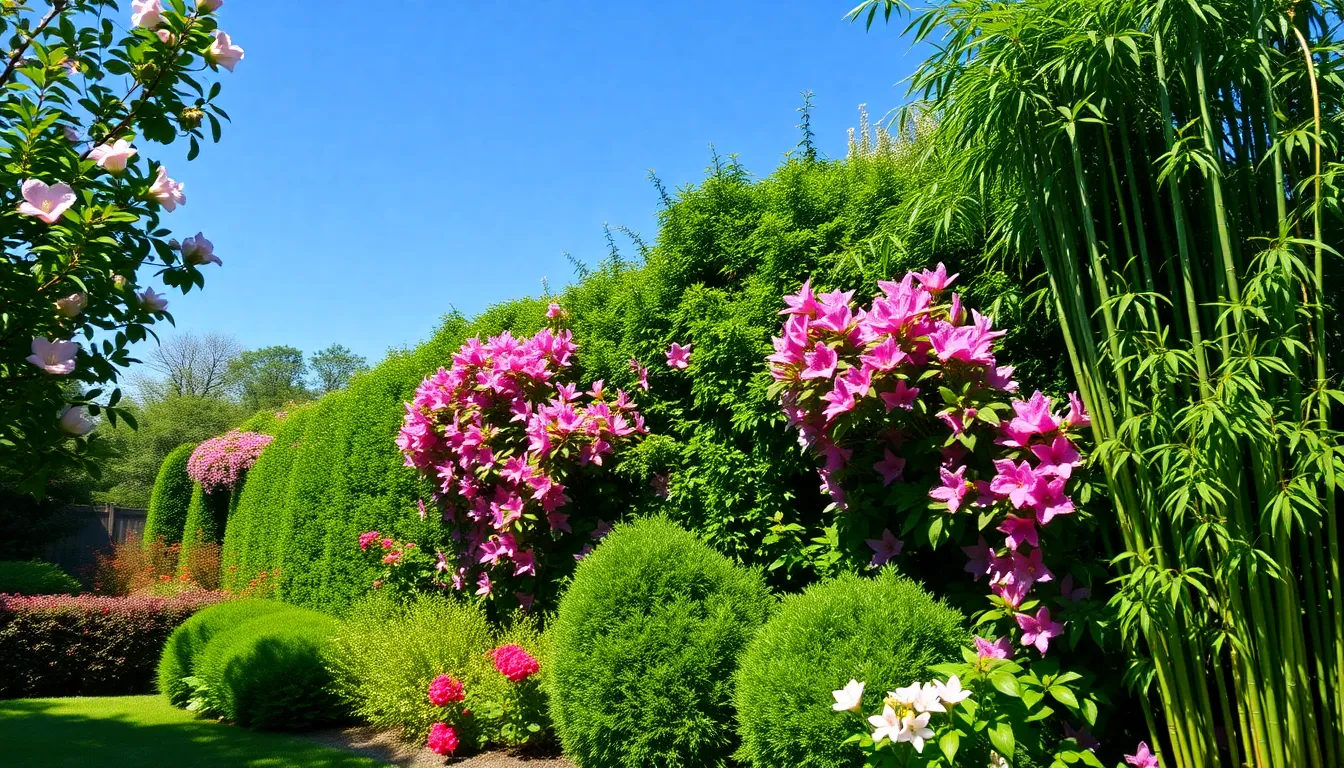
We can transform our privacy screens into ever-changing displays that change throughout the year by selecting plants that offer different seasonal highlights. Creating visual interest across multiple seasons ensures our living fence remains attractive and captivating year-round.
Spring Flowering Options for Early Color
Clematis varieties deliver spectacular early season blooms with large, showy flowers in purple, pink, white, and blue hues that cascade beautifully along fence lines. Growing these climbing plants on or near existing fences creates vertical color displays that signal the arrival of spring while maintaining privacy coverage.
Azaleas (Rhododendron spp.) provide vibrant spring blooms in shades ranging from soft pastels to bold magentas, with mature plants reaching up to 20 feet tall and wide. Pruning these flowering shrubs after blooming allows us to shape them into dense privacy barriers while preserving next year’s flower buds.
Sweet Viburnum combines practical screening with aesthetic appeal through clusters of fragrant white flowers that appear in early spring. These versatile shrubs serve dual purposes as privacy hedges and ornamental features, offering both function and beauty in our industry design.
Summer Foliage Plants for Dense Coverage
Yews (Taxus spp.) create exceptionally dense evergreen screens that maintain thick coverage throughout the summer months. Trimming these hardy shrubs into various shapes and sizes allows us to customize our privacy barrier while ensuring consistent year-round screening.
Bamboo (Bambusoideae) ranks among the fastest-growing plants for summer privacy, with tall leafy stalks forming lush, dense screens in a single growing season. Selecting clumping varieties prevents aggressive spreading while providing rapid height and coverage for immediate privacy results.
Boxwood shrubs maintain their lush, dense appearance during hot summer months, creating monolithic privacy hedges through regular shearing. These evergreen workhorses provide consistent screening while tolerating heat and humidity better than many other hedge plants.
Green Giant Arborvitae forms thick privacy walls during summer with fast growth rates of 3 to 5 feet annually. These tall evergreen trees create substantial barriers that block views effectively while maintaining their dense foliage throughout the warmest months.
Fall Color Varieties for Autumn Appeal
Loropetalum varieties showcase attractive purple foliage that intensifies during fall months, creating colorful privacy screens with seasonal drama. These unique shrubs maintain their screening function while adding rich burgundy and plum tones to our autumn industry.
Privet hedges (Ligustrum spp.) offer subtle fall color changes in their foliage while maintaining dense coverage for continued privacy. Some varieties display yellow or bronze tints during autumn, adding seasonal interest without compromising their screening effectiveness.
Deciduous flowering shrubs including viburnums and azaleas contribute fall color displays through changing leaf colors while providing privacy until leaf drop. These plants offer the best of both worlds with spring blooms, summer screening, and autumn color before entering winter dormancy.
Creative Mixed Plantings for Unique Privacy Solutions
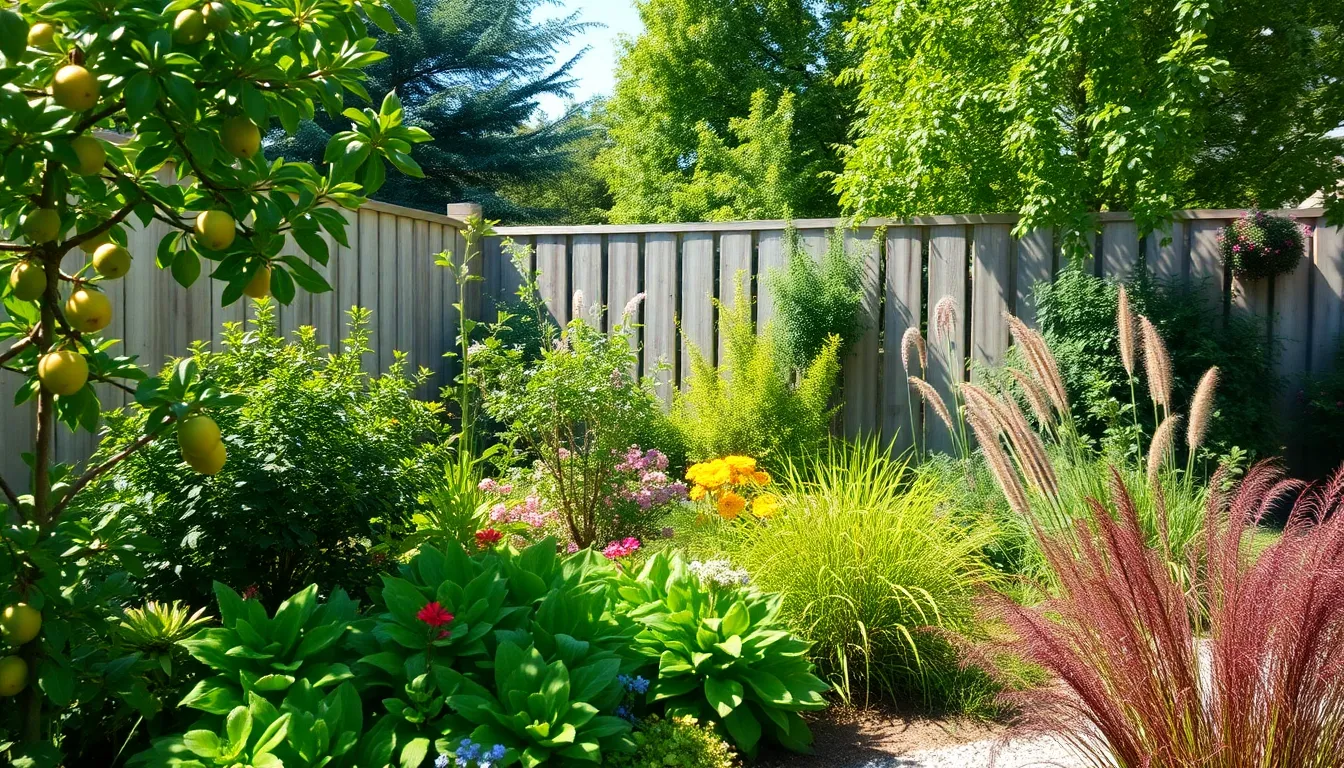
Mixing different plant types creates ever-changing privacy screens that offer multiple benefits throughout the year. We’ll explore three innovative approaches that combine beauty with functionality.
Edible Privacy Hedges with Fruit Trees
Fruit trees along fence lines transform ordinary barriers into productive privacy screens. Apple and pear trees planted 6 to 8 feet apart create natural hedges that produce fresh fruit while blocking unwanted views. Berry bushes like raspberries and blackberries form dense thickets that serve dual purposes as privacy screens and food sources.
These edible hedges require annual pruning to maintain their screening effectiveness and fruit production. We recommend choosing dwarf or semi-dwarf varieties for easier maintenance and better proportions along fence lines. Blueberry bushes work exceptionally well as low to medium height privacy options, offering spring flowers, summer fruit, and brilliant fall foliage.
Herb Gardens Along Fence Lines
Herbs create fragrant privacy boundaries that provide fresh ingredients for your kitchen. Rosemary, lavender, thyme, and sage form low hedges that naturally deter pests while attracting beneficial pollinators. These aromatic plants thrive in narrow spaces between fences and walkways.
Taller herbs like rosemary can reach 4 to 6 feet in height, contributing significantly to privacy screening. Lavender varieties add purple blooms and soothing scents that enhance outdoor relaxation spaces. We suggest planting herbs in staggered rows to create layered screening that maximizes both privacy and harvest potential.
Mediterranean herbs perform best in well-draining soil and full sun conditions. Their drought tolerance makes them excellent low maintenance options for privacy plantings.
Ornamental Grass Combinations
Ornamental grasses provide soft, natural movement along fence lines while creating effective privacy screens. Feather reed grass, maiden grass, and fountain grass combine beautifully for varied heights and seasonal interest. These grasses grow densely and offer vertical screening that complements existing fence structures.
We recommend mixing different grass varieties to achieve 3 to 8 feet of screening height. Miscanthus varieties like ‘Gracillimus’ and ‘Morning Light’ create tall privacy walls with attractive plumes and seedheads. Fountain grass adds lower level screening with graceful arching habits.
These low maintenance plants tolerate various soil conditions and provide year-round structure. Their vertical growth pattern fits perfectly next to fences without taking up excessive ground space.
Conclusion
Creating your perfect privacy fence with plants doesn’t have to be overwhelming. We’ve shown you countless options that work for every budget timeline and garden style – from fast-growing bamboo to beautiful flowering hedges.
The key is choosing plants that match your exact needs and climate zone. Whether you prefer low-maintenance natives quick-growing evergreens or creative mixed plantings there’s a natural solution waiting for your space.
Your outdoor sanctuary is just a few plantings away. Start with one section test what works best in your yard and gradually expand your living fence as your plants establish and thrive.
Frequently Asked Questions
What are the fastest-growing plants for privacy screening?
Bamboo is the fastest option, with clumping varieties growing 2-4 feet per season. Leyland cypress grows 3-4 feet annually and can reach 40-60 feet at maturity. Green Giant arborvitae also grows 3-5 feet per year, providing dense evergreen coverage. These options offer quick establishment for immediate privacy needs.
Which flowering shrubs work best as privacy barriers?
Lilac bushes create dense natural barriers with sweet fragrance, thriving in full sun. Forsythia shrubs provide vibrant yellow blooms in early spring while growing quickly. Hydrangeas, particularly ‘Limelight’ and ‘Little Lime’ varieties, offer substantial coverage with impressive flowering displays in zones 3-8.
How do I create a layered privacy planting system?
Use a three-tiered approach: tall background plants like arborvitae for primary screening, medium-height shrubs like lilacs and forsythia to fill gaps, and low-growing ground cover including ornamental grasses. This layered system ensures complete visual blocking while maintaining a natural garden appearance.
What climbing vines are best for transforming existing fences?
Ivy provides reliable evergreen coverage with minimal maintenance, creating classic green walls. Clematis varieties offer colorful displays throughout the growing season. Honeysuckle combines fragrant flowers with dense foliage, enhancing both visual appeal and sensory experience of privacy walls.
Which native plants require the least maintenance for privacy?
Regional evergreens like hazelnut and Coastal Pink Correa are resilient and drought-tolerant. Westringia and native viburnums provide effective screening while supporting local wildlife. Native grasses create soft, natural boundaries that complement shrub-based fences with minimal water and maintenance requirements.
Can I create edible privacy hedges?
Yes, fruit trees like apple and pear block views while producing fresh fruit. Berry bushes such as raspberries and blackberries serve dual purposes as privacy screens and food sources. Herb gardens with rosemary and lavender create fragrant boundaries while repelling pests naturally.
How do I ensure year-round privacy coverage?
Focus on evergreen options like arborvitae, Leyland cypress, and yews for consistent coverage. Combine with seasonal interest plants: spring clematis and azaleas, summer bamboo and boxwood, fall loropetalum and privet hedges. This variety maintains attractive screening throughout all seasons.
What spacing is required for privacy hedge plants?
Proper spacing depends on the plant type and mature size. Leyland cypress requires adequate spacing for optimal growth and annual pruning. Bamboo needs proper spacing between clumps for healthy development. Always research specific plant requirements and allow room for mature width to prevent overcrowding.

